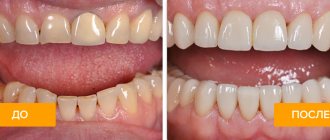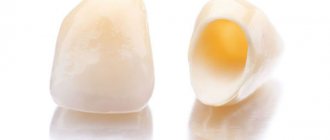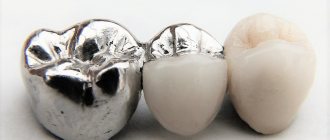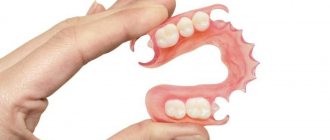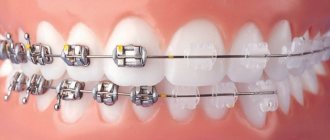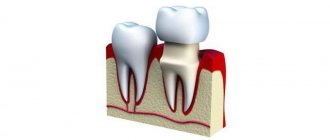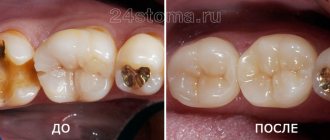Installing a crown on a tooth is one of the prosthetic options used when one or more dental units in a row are lost. Sometimes a dental crown is required even in the absence of a single edentia - for example, if it is necessary to restore the aesthetics of the dentition in the smile area. There are specific indications and contraindications for the procedure, and it is performed in several stages. We will discuss the specifics of the process of installing dental crowns in detail below.
After reading the material, you can find out how to install a crown on a tooth, what types of structures can be used in the procedure, and whether the process will be painful for the patient. We will also separately consider the specifics of removing a dental crown.
Calculate the cost of treatment by taking a short test in 20 seconds!
Do not delay your treatment, because in this matter time plays against us.
Indications for prosthetics by installing dental crowns
There are certain indications for installing a crown on a tooth, as for any other dental procedure. In what cases is prosthetics with dental crowns performed? It would be advisable to carry out the procedure in the following circumstances:
- Significant destruction of dental units by deep caries.
- Traumatic tooth destruction, in which the unit still has healthy roots.
- Aesthetic defects: noticeable discoloration of the enamel coating, chips.
Also, the installation of temporary crowns will be justified in case of periodontitis: the design will prevent further loosening of the teeth and, accordingly, will protect them from falling out. Indications for crown installation are determined during a diagnostic examination. Do you need to get a crown on your tooth? The orthopedists of our dentistry in Moscow - VENSTOM - will help you find the answer to this question! Come see a specialist at any time convenient for you. We are located next to the Baumanskaya metro station, you can walk to the clinic from the metro in just five minutes!
Disadvantages of using metal-ceramic crowns
But when talking about metal-ceramics, you need to be well aware of the potential disadvantages of such technology. These include:
- Load control. Even though you can eat hard foods, you still need to be careful with nuts and other particularly hard foods.
- The need for surgical intervention. Depulpation will be required. Also, when using some types of technologies, such as casting, it may be necessary to grind down adjacent teeth.
- High requirements for materials. The highest quality materials that do not cause allergies are expensive. The optimal solution would be to install a crown made of an alloy of precious metals.
- There is a risk of allergies. Not all materials are suitable for all patients. Some people may experience irritation on the mucous membranes.
- Possibility of oxidation. There are types of alloys that, when oxidized, begin to create an unpleasant ferrous taste in the mouth.
At your first appointment with a doctor, he will answer your questions and tell you about indications and contraindications. He will also conduct a susceptibility test to different types of alloys that could potentially cause allergies.
Does it hurt to put a crown on a tooth?
The question about the pain of installing dental crowns is the most common question among patients. And it should be noted that it is impossible to eliminate 100% discomfort during the procedure - the process of preparing for prosthetics will be most unpleasant for the patient. At this stage, the doctor will drill the teeth to gain access to the canals for their subsequent cleaning and filling.
These manipulations can be quite painful and therefore, to reduce the degree of discomfort, the specialist uses anesthetic drugs. Modern anesthetics completely remove pain, their effect lasts about 3 hours and this time is enough to complete the preparation for prosthetics. The process of installing crowns itself does not cause pain, since the structures are placed on pulpless or, more simply put, dead dental units in which there are no nerve endings.
In our dentistry in Moscow, VENSTOM, dental prosthetics with crowns are carried out using modern anesthetics, which completely eliminate unpleasant and painful sensations during treatment! You can get a detailed consultation on prosthetics by visiting our clinic. We are located next to the Baumanskaya metro station.
Stages of prosthetics
The prosthetic procedure includes the following steps:
- Diagnostic
- dental examination, diagnostics (orthopantomogram, CT scan), hygienic cleaning, treatment of teeth and gums (according to indications). - Preparatory
- preparation of supporting units (preparation, filling of canals, strengthening of roots with an inlay or pin (if necessary), giving the stump the desired shape), installation of a temporary protective structure. - Laboratory
- the stages of manufacturing a metal-ceramic prosthesis in dentistry do not differ from the creation of orthopedic systems from other materials:
- taking impressions of the patient’s jaws;
- making a plaster model;
- wax modeling of the structure;
- production of metal-ceramic prosthesis with polishing and grinding.
- Fitting and installation
- after fitting, the orthopedic system is fixed to the prepared supports with cement.
The metal-ceramic structure is attached to the abutment (adapter between the implant and the supragingival part) using the screw method or composite cement.
The main stages of the procedure for installing a dental crown
Installing a crown on a tooth - this procedure is usually divided into several stages, which will be useful to get to know before your initial visit to the dentist. The main stages of the process of placing dental crowns will be discussed in detail below.
First visit to an orthopedic dentist
During the initial appointment, the specialist examines the patient’s oral cavity, prescribing additional tests if necessary. Based on the data obtained, the doctor develops a treatment plan, offering the patient possible options for restoring lost teeth or dentition aesthetics. The treatment plan takes into account not only the need to install a denture, but also additional manipulations, including: Removal of severely damaged and non-viable dental units;
Treatment of the patient’s dental and oral diseases: caries, pulpitis, root canal filling, oral sanitation.
Next, a specific type of dental crown is selected and the cost of turnkey prosthetics is calculated and the timing of its implementation is also determined.
Types of metal-ceramic prostheses
All known methods of prosthetics are divided into 3 types - classic removable and fixed structures, dentures on implants (conditionally removable).
- Removable
dentures made of metal-ceramics are fixed to supporting units using clasps (hooks), attachments (micro-locks) or telescopic crowns. A popular representative is the clasp prosthesis, for the attachment of which you need at least two points of support (your teeth or implants). - Fixed
metal-ceramic dentures (crowns, bridges of varying lengths) are fixed to abutment teeth or implants. Use a cement or screw (when installing on abutments) method of fastening.
The type of orthopedic system is selected in accordance with the nature of the damage and the extent of the defect.
Preparing to install dental crowns
Traditionally, crowns are placed on dead (pulpless) teeth, but sometimes there is a need to install a structure on living teeth. This has a positive effect on the final result of prosthetics, since living dental units are stronger and less susceptible to destruction processes, which ensures a long useful life of the crown. Usually, chewing teeth are not depulped during prosthetics. They have a significant area of the natural crown and the distance from the enamel layer to the pulp is greater, which eliminates burns to the natural tissues of the oral cavity during prosthetics.
Differences between metal-ceramics and other materials
This orthopedic design has gone through a long path of development and change before becoming what we see it today. Among dentists, this type of product is considered one of the most functional and aesthetic.
The issue of biocompatibility also fades into the background - many installation technologies do not require implantation into the bone tissue of the base gum.
Traditional alternatives are zirconium and all-ceramic crowns.
But they are more expensive, and many have contraindications for installation and are less durable.
The system also has its own peculiarities.
Among them:
- Possibility of installation on a severely damaged tooth. You can get a crown even if you are missing more than half a tooth.
- The design includes a special frame. It allows both parts of your new tooth to bond well.
- Externally, a crown can hardly be distinguished from a regular tooth. It is characterized by the same high strength.
When describing such an orthopedic product, it is also necessary to take into account the materials used in the manufacture of the frame. The three most common types of alloy used are:
- Noble metals. Many types of materials are actively used in production - from gold and platinum to palladium. The main advantage of using such an alloy is that there is no oxidation. It is very easy to use and allows you to create a tooth that exactly replicates the natural one in shape.
- Chrome-nickel. More affordable than noble metals, but susceptible to oxidation. This does not affect the strength of the crown itself, but the client may begin to feel a metallic taste in the mouth. There is also a risk of developing allergies.
- Cobalt-chrome. A good intermediate option both in price and in other characteristics. Rarely causes allergies or irritation, very durable. But, as in the case of chromium-nickel alloys, it is better to check in advance for any unwanted reactions.
The question of which crown option is best to install is quite complex. It requires consultation with a dentist, tolerance tests, and diagnostics. Based on the results, you will be offered the optimal solution.
Free consultation on the cost of treatment in our dentistry
Leave a request and the clinic administrator will contact you within 15 minutes!
For single-rooted dental units, the depulpation process is mandatory, since the risks of thermal burns during grinding are quite high and this is fraught with the future development of an inflammatory process under the crown. Single-rooted teeth are drilled out, the nerve is removed, and the canals are cleaned and filled.
If there are dental diseases - caries, pulpitis, periodontitis - manipulations are performed to treat them. The nerves of the unit are removed, the canals are expanded with a special instrument, filled with gutta-percha, after which a filling is installed on the tooth itself. In case of serious damage to a tooth due to caries, it is important to install a strong filling and provide additional fixation. If this is not done, the dental crown may simply fall out along with a poor-quality filling. The process of restoration of a natural dental crown can be implemented in practice using two methods:
1. Installing a crown on a pin. The pin element is screwed into a pre-filled root canal and the natural coronal part of the tooth is restored at its base. After the filling is made, it is ground down to install the crown.
2. Using a stump insert. This element is manufactured in laboratory conditions and, when installed, is fixed in two areas at once: the dental canal and the area of the natural tooth crown.
These labor-intensive manipulations are carried out exclusively in the presence of serious destruction in the area of the natural dental crown, and if we compare the methods in terms of reliability, then the most high-quality result can be obtained by placing a stump inlay.
Features of prosthetics of anterior and chewing teeth
Metal-ceramic orthopedic systems are used to replace any group of teeth. Installation of metal ceramics on the front incisors takes into account the characteristics of the frontal zone. Impeccable aesthetics will be ensured by a frame made of precious metals. To avoid a blue margin at the gingival margin, dentures with a shoulder mass or shoulder are used. The designs have an increased ceramic layer; the cladding does not end at the base, but is folded over to cover the metal. This improves the aesthetics of the orthopedic system in the cervical area - the metal does not show through the gum, the prosthesis looks natural even when the gingival margin subsides.
Prosthetics of molars is performed using standard technology - strength and functionality are important for the chewing zone, aesthetics takes second place here.
Grinding teeth for crown installation
The professional name for the process of grinding teeth for installation of crowns is preparation, which is performed with a special device - a drill. Using diamond burs, the doctor gives the dental units the shape that will allow the crown to be firmly installed. Grinding can be a rather painful procedure for the patient if dental units that are not previously depulped are subjected to treatment. In this case, local anesthesia is required.
Natural tooth tissue is removed by a specialist to the thickness that the crown will have. On average, up to 2.5 millimeters of dentin can be removed from each side of the unit, depending on the type of crown prosthesis. Cast crowns require minimal grinding of teeth; maximum layers of tissue are removed before installing ceramic and metal-ceramic products. After grinding, a stump base remains from the tooth, on which the prosthetist will subsequently install a crown.
Life time
The service life of the product may be reduced for several reasons:
- loosening of the tooth due to developing periodontal disease or periodontitis, less often due to the absence of an adjacent tooth or bruxism;
- violation of the tightness of a two-layer crown due to the use of low-quality materials or careless handling on the part of the patient;
- tooth decay due to reasons: hormonal imbalances, metabolic disorders, poor dental care, lack of calcium.
- chipping or breaking of the crown as a result of injury, biting hard food, malocclusion or bruxism.
Taking impressions and making crowns
An impression is taken of the prepared dental units. For this procedure, a special dental plastic mass is used. An impression is necessary to make an exact plaster copy of the patient’s teeth, which will be used to create a permanent structure. For the production of crowns, different types of materials can be used - metal, metal-ceramics or ceramics. The specific type of raw material is selected based on the characteristics of the case and the wishes of the patient.
The production time for dental crowns depends on the type of material chosen. The production process of ceramic and metal-ceramic products takes the longest. If structures made from these materials are chosen for prosthetics, then temporary dental crowns made of plastic are made for the patient during the period of their manufacture. Temporary crowns will help to recreate the aesthetics of the dentition and, in addition, will protect the ground and weakened teeth from the destructive effects of external factors.
How to properly care for crowns?
The duration of use of metal ceramics directly depends on whether the patient is ready to follow the rules of care for them. There are several basic requirements:
- Regular proper brushing of teeth. The standard cleaning frequency is twice a day. In this case, you should move the brush vertically, from the gum to the edge.
- Careful selection of brushes. You will need to use a model exclusively with soft bristles. Pasta doesn't matter.
- Use dental floss. The space between the teeth should be cleaned especially thoroughly.
- Buy a rinse aid. It can also be replaced by regular rinsing with regular purified water.
If you smoke, often drink tea, coffee and other types of drinks with strong coloring ingredients, it is worth making an appointment for professional cleaning - at least twice a year.
Otherwise, care and precautions are the same as for everyday life without metal ceramics. It is better to eat solid foods carefully and not to overindulge in too cold or hot foods and drinks.
Trying and installing a crown
At the stage of manufacturing crowns, a preliminary fitting is required, which will allow us to evaluate the accuracy of manufacturing structures for the patient’s teeth and the tightness of the product. If all is well, the crown manufacturing process ends, the finished prosthesis is handed over to the orthopedist and the patient is invited to the specialist’s office for preliminary temporary fixation of the structure.
Temporary fixation of the crown is an event necessary to check the quality of the crown installation. The specialist will also evaluate the tightness of the prosthesis to the ground teeth and make sure that the closure of the crown with the opposing teeth occurs correctly. When temporarily fixing dental crowns, permanent cement is not used, and this allows you to quickly remove the structure if any defects are detected during its operation.
The assessment of the quality and convenience of the crown during temporary fixation is carried out within a certain period of time, which on average is 2-4 weeks. If no defects are identified during this time period and the patient does not complain of discomfort, the crown is fixed with heavy-duty permanent cement. This completes the prosthetic process.
Calculate the cost of treatment by taking a short test in 20 seconds!
Do not delay your treatment, because in this matter time plays against us.
How long will metal ceramics last?
One of the advantages of metal-ceramic crowns is their long service life. The product will retain all its positive characteristics for more than 12 years. However, there are several factors that can affect the duration of use of metal ceramics.
Among them:
- The quality of the original prosthetics. It is important that the dentist grinds the required amount of ceramics and performs the treatment. There should be no inflammation, swelling or other signs of disease at the installation site.
- An orthopedist must be a professional. It is important that the enamel is ground correctly and that there are no external defects left on the tooth, including small irregularities and bumps. If there are any unevenness, food will get into these grooves, which will create problems with the microflora and the crown.
Also, the patient himself must follow the rules for using metal ceramics so that your new tooth does not break or become damaged.
Removing dental crowns: indications and features of the process
Removing dental crowns is a procedure that becomes necessary if certain complications arise after installing the prosthesis. Removal of the structure may be required in situations:
1. Poor quality preparation for dental crown prosthetics. If the tooth canals are poorly cleaned and poorly sealed, then an inflammatory process may begin to actively develop in them. If such a process occurs, the crown will need to be removed and the tooth treated or removed.
2. Inaccuracies in the manufacture of a crown on a tooth, in which the installed structure will overestimate the bite and not fit tightly to the tooth.
Crowns are also removed for planned replacement. High-quality structures can last up to 10 years or more, but after that the crown will be replaced with a new orthopedic product. Crown removal may be uncomfortable for the patient, so it is usually performed using local anesthesia. To remove the structure, it is sawed with a bur, removed, and those medical manipulations that are necessary for a particular case are performed.
We hope the material helped you learn all the important nuances of installing crowns on your teeth, and you can always get more detailed advice on prosthetics from the dentist at our Vanstom clinic in Moscow! To make an appointment, just call us!
Installing a pin on 1 tooth or restoring a tooth on a pin
This method is suitable for those patients who consider the presence of a tooth root without its crown to be an absence of a tooth. If a root is present, in some cases it is possible to restore the tooth on a pin.
To install the post, the dentist uses a drill to treat the area where the tooth has chipped or damaged the crown. Then, as if using a drill, he creates space for the screw inside the root of your natural tooth. This space is usually created within one of the root canals if the tooth is multi-canal. After the screw is installed in the root, the tooth is restored with filling material on top, which ensures the further placement of a metal-ceramic crown on it.
If there is a strong root, the tooth can be restored by installing a pin into the root. In the case of a pin insert, the dentist prepares a space in the root of the tooth and takes an impression, from which a cast pin with a small “stump” is made in a dental laboratory, simulating a tooth, onto which the crown is subsequently fixed.
This method allows you to preserve a healthy tooth (or root) for another 7-10 years with proper care. The decision on the possibility of preserving the root of the tooth, as well as installing a pin in it, or restoring it on a pin, is made only by a dentist.
For more detailed consultations and an individual treatment plan, you can contact Estet Dentistry by calling 241-10-90. After a detailed examination of the oral cavity, as well as based on your budget and wishes, the clinic’s specialists will select the optimal solution just for you.
Is there an alternative to metal ceramics?
It is not difficult to replace metal-ceramic crowns; the most difficult thing will be the choice between the desire for a beautiful smile and the desire to save money. When making a decision, consider where exactly in the dentition the organs that require restoration are located:
- Frontal teeth. Here it is better to prefer aesthetics and opt for metal-free prostheses made of zirconium dioxide or porcelain crowns. In addition, the chewing load on these teeth is minimal. And in any case, you will have to say goodbye to the bad habits of biting threads and gnawing seeds.
- Chewing teeth . Functionality and reliability are more important here. You can install an all-metal crown, which will give odds to even metal-ceramics in terms of strength, durability and gentle pre-treatment of the tooth before prosthetics. The main thing is to make sure that such a crown will not shine from the depths of the mouth when talking and smiling, because this is unacceptable, for example, for public people or those occupying high positions.
- Combination of teeth . Let's say a patient needs to install a bridge between the fourth and sixth teeth. The number four is exposed when you smile, and this tooth attachment is made of metal ceramics, while the other units are solid cast metal. In addition, less teeth are prepared for metal structures, which means the bridge will last longer. Let’s assume an option that combines metal-free and metal-ceramic units. This will reduce the cost of the design without compromising the aesthetics.
